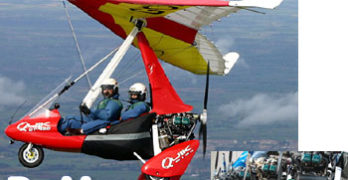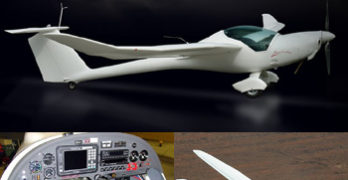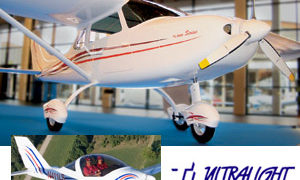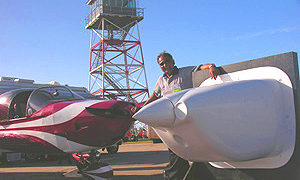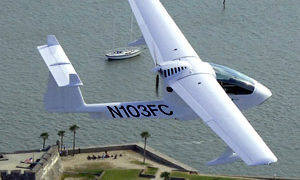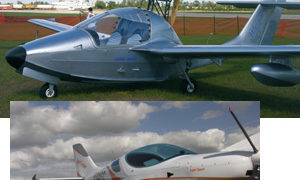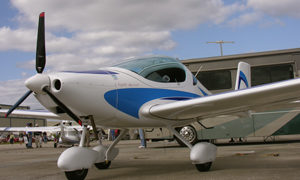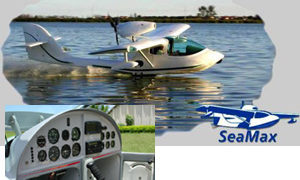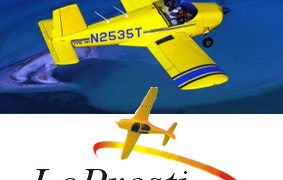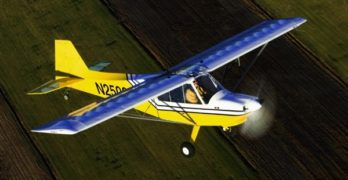Two weight shift aircraft from England carried the list of Special Light-Sport Aircraft past the 60 mark. Welcome to the P&M Aviation Quik and Quik GT450, our two newest SLSA models and the 7th and 8th weight shift aircraft (adding to 5 powered parachute models and 48 fixed wing airplanes, 2 of which fall into the Glider category). P&M Aviation was formed from a merger of Pegasus Aviation and Mainair Sports, the two leading UK trike builders. *** The P&M Quik models are modestly priced compared to other trikes from Europe. You can buy a Rotax 912-powered Quik for just over $50,000, which is substantially lower than other 912 trikes. The price tag also qualifies as one of the least costly SLSA. *** P&M Aviation USA is the American importer of the British brand. They’ll be at Sebring 2008 where you can see the Quik models with a larger control panel to allow for more instruments.
Search Results for : Sebring Expo
Not finding exactly what you expected? Try our advanced search option.
Select a manufacturer to go straight to all our content about that manufacturer.
Select an aircraft model to go straight to all our content about that model.
Urban Air USA Brings Lambada Closer
Bostik Industries is known to some LSA buyers as “the other supplier” of emergency ballistic parachute systems (Magnum). Indeed, that activity appears to be thriving as major producer BRS Parachutes intensifies its focus on larger GA airplanes and light jet projects. *** An affable Joe Bostik (airline captain and champion hang glider pilot) is also the U.S. agent for the shapely Lambada motorglider. Though soaring pilots will be instantly drawn to this reasonably priced motorglider (less than $100,000; other choices can cost much more), the airplane also works as a cross country cruiser, able to fly 800 nautical miles at speeds of 100 mph. Though Rotax 9-series engines offer great reliability, should the powerplant go quiet, a Lambada pilot can glide up to six miles from only 1,000 feet off the ground. Bostik now has his Lamabada website well populated with info, specs, and photos.
SportairUSA to Unveil Sirius High-Wing LSA
With events like Sebring and Sun ‘n Fun, AirVenture Oshkosh is a grand venue to introduce something new…or something coming soon. The mockup of the Cessna Sport won’t be the only new model. SportairUSA has represented the low-wing, all-carbon-fiber StingSport since LSA arrived on the scene and it has earned a spot in the top five list of best sellers. *** At Oshkosh 2007, SportairUSA will preview a “cabin model” of the TL 3000 Sirius. The company says, “Flight testing is expected to be completed in the fall, with aircraft ready for USA delivery in 2008.” They elaborate on the sleek high wing saying, “Sirius will be constructed of the same carbon fiber composite materials as the StingSport and powered by the Rotax 912 engine series with a generous, 48-inch-wide cabin and room for golf clubs in the back. Folks who saw the full size mockup at Germany’s Aero show were impressed.
Nose Job and New Boots for Thorpedo LP
How to extract more performance from a 60-year-old design? How about a nose job? Pilots understand a smoother shape lends more speed to a design, but you may not sense the total gain possible without adding horsepower or burning more fuel. General aviation companies like Mooney, Cessna, and Piper hired LoPresti Speed Merchants to help boost speed. *** At the 2007 Sebring LSA Expo IndUS Aviation revealed a new LoPresti nose cowl for their Thorpedo LP; plus reshaped wing tips which enclose nav and landing lights plus strobes, and new landing gear fairings…which, being Texans, they called “cowboy boots.” LoPresti engineers say the streamlined improvements will boost Thorpedo’s speed near the LSA limit of 120 knots. A 75% power cruise gain of 20% is forecast. The new components modernize the lines of this venerable John Thorp design from the 1940s, though it may seem hard to improve on a airplane that never required a single Airworthiness Directive!
LSA Aero Wins #2 FAA Amphib Exemption
Perhaps it’s a little ironic that Freedom wins its freedom. When I spoke with importer Don Langford at the Sebring LSA Expo he sounded somewhat unsure about the future for his Spanish amphibian. He’d submitted information for an exemption but had no reply. Yet shortly after Expo ended FAA granted LSA Aero‘s request for the Colyaer Freedom S100. The exclusive club now includes Czech Aircraft Works’ Mermaid and the Freedom. *** Each person exercising Sport Pilot privileges is required to obtain additional ground and flight instruction — on landing gear inspection, operation, and emergency procedures to include six takeoffs and landings and three in-flight gear movements. After a logbook endorsement and with appropriate placards on the aircraft, a Sport Pilot is allowed to move the gear as designed. Congratulations to Don and LSA Aero. This may help crack the door open wider for other amphibious LSA.
Fully Finished…Revised Mermaid & SportCruiser
At the Sebring LSA Expo, visitors saw two airplanes they’d seen before, but these were actually revised models that are now ready for waiting pilots. The Mermaid charmed the LSA world when it was first introduced, since collecting more than 200 order deposits. The boat hull LSA also earned the first of two exemptions regarding the “repositionable” gear detail that has so befuddled FAA lawyers. The agency says it will fix this part of the SP/LSA rule by May 2007 but Mermaid is one of only two amphibs that allow Sport Pilots to reposition the gear. [UPDATE: LSA Aero’s Freedom S100 also recently won an exemption.] Mermaid’s engine now sits up on struts. Not only does this look great, the change has solved prior challenges of the Jabiru 3300 engine installation. It is also said to decrease noise. *** SportCruiser may look the same to you but the “third generation” model is said to fly better and it certainly looks sleeker with its beautifully shaped canopy.
A Mystique, Yes; But Not a Mystery
LSA America is a newly formed company separate from but associated with Fantasy Air USA, importer of the very successful Allegro*. The new company displayed their Mystique from Flying Machines, which won SLSA #46 just before the Sebring LSA Expo. This lovely bird has smooth flowing lines all the way to a squared off vertical stabilizer. I took a test flight in Mystique to find a light handling airplane with huge visibility. Built in the Czech Republic, Mystique joins Interplane’s Skyboy in LSA America’s lineup. Mystique has a contemporary appearance and equipment neatly fitting the LSA mold and looks second generation compared to the low-cost Skyboy. Look for my report in EAA Sport Pilot soon (perhaps the March or April 2007 issue). On less than 26 feet of span, Mystique boasts a 15:1 glide; such performance is hard to judge in an hour flight but clearly Mystique held energy well.
Unveiling SeaMax to American Amphib Fans
My old friend Malcolm Jones* and Carlos Bessa will unveil a lovely amphibian LSA called SeaMax at the Sebring LSA Expo starting tomorrow. SeaMax by Brazilian producer AirMax intends to achieve Special Light-Sport Aircraft status but it has been cutting through waves in other countries for several years. SeaMax is a lighter amphibian, with gross weight at 1,144 pounds (a max of 1,430 is allowed). At 660 pounds empty, the composite seaplane yields a 484 pound useful load and can carry up to 25 gallons of fuel. SeaMax can lift off the water in only 325 feet. Electrically operated landing gear can be lowered into the water for taxiing onto a beach. SeaMax has a broad 46-inch wide cockpit and lots of attention to detail has been paid to the speedboat-like interior finish. * Malcolm operates a favorite hang gliding airpark called Wallaby Ranch just eight miles south of Disney Florida.
Thorpedo Gets a Boost From Speed Merchant LoPresti
One sign that Light-Sport Aircraft have arrived is when a well-known general aviation company joins forces with a LSA leader. That’s what occurred when IndUS Aviation, producer of the Thorpedo and Sky Skooter, retained Vero Beach, Florida-based LoPresti Speed Merchants. You surely know the legendary Roy LoPresti operation that gained fame by working with major airframe builders to extract more speed from their designs. Though Roy died last August, the company continues its “brain trust” work to squeeze speed from an airplane without adding horsepower. Those speed mods are now going to quicken the cruise of a new Thorpedo LP. At the Sebring LSA Expo in just four days, you can get first-hand info on components that will make a new, faster Thorpedo. *** You may also want to ask the IndUS folks why FAA Administrator Marion Blakey paid a three-hour visit to their operation in India.
Proven again: Rans’ newly approved S-7LS
You’ve probably heard the tongue-in-cheek expression, “No good deed goes unpunished.”
RANS President Randy Schiitter knows this saying in a way no other light-sport aircraft
(LSA) producer can. When the company’s S-7 Courier earned special light-sport aircraft
(S-LSA) approval on October 24, 2005, it was the second time this aircraft
was certificated as a ready-to-fly (RTF) airplane, after first being designed as a kit.
RANS earned Primary Category certification
for this aircraft, as the S-7C
model, 10 years ago when that FAA regulation
was the latest big thing in aviation.
It took the Kansas company years
to complete that certification process,
but the recreational pilot certificate and
Primary Category certification failed
to meet industry expectations. After
spending lots of time and money earning
that approval, RANS didn’t jump
on the LSA bandwagon immediately.
The S-7 Courier was the first twoseat
aircraft produced by RANS, dating
to 1985 when the first prototype flew.


